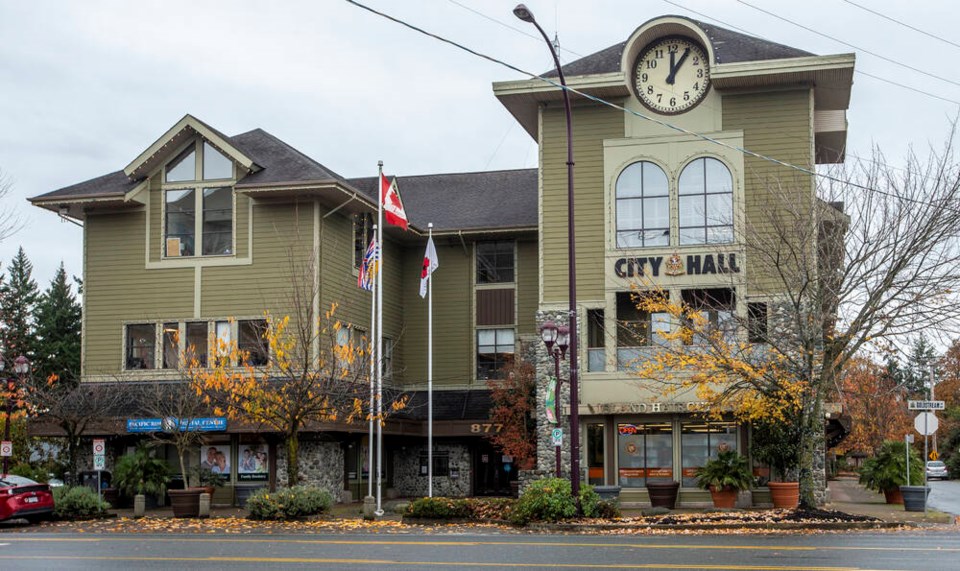Langford council has rejected a motion to develop a tree-protection bylaw, saying the city’s development permit process is already protecting trees and environmentally sensitive areas.
The decision leaves Langford as the only municipality of 13 in the Capital Regional District without a specific tree-protection bylaw.
Mayor Stew Young said Langford has something “better and much more efficient.”
Young said about 70% of Langford is within designated development permit areas and the zoning process since 2008 stipulates 40% of each site has to be set aside for tree protection and green spaces.
That has already been applied to major projects such as Bear Mountain, South Skirt Mountain and Westhills, where thousands of additional trees have been also been planted, he said.
A staff report said the development permit process is considered a more comprehensive solution to tree protection, “as it allows for whole ecosystems to be considered, not simply a tree-by-tree approach.”
Young said the remaining 30% of Langford — private property owners — should be able to do that they want with their trees.
“You’re creating red tape, bureaucracy where it’s not needed,” said Young, referring to the bylaw motion. “The people in Langford are very good at managing their own properties.”
Young said if a family wants to put an addition on their house for a family member during the housing crisis, the city shouldn’t be tying up the process for weeks or months with a bylaw that could cost taxpayers and homeowners thousands of dollars.
“For us to come in and start to charge $2,000 and a permit and to put somebody through a two- or three-year process to take a tree down … that’s unacceptable,” said Young.
“We’re not in a tree crisis. We’re in a housing crisis, pandemic, an opioid crisis … there isn’t a tree crisis in Langford.”
Langford has already identified several heritage trees, Garry oak groves and significant stands within its borders in its core and along Glen Lake and Humpback roads.
The staff report said initiating a tree-protection bylaw could hasten, not hinder, tree-cutting, “as anyone with a tree that they might want to remove would do so before a bylaw could be passed.”
But Coun. Lillian Szpak, who made the bylaw motion, rejected that idea.
“I simply don’t think that’s true now,” she said. With growth in Langford, changing demographics and greater understanding of the health and climate benefits of trees, the city is at a point that it could adopt a tree-protection bylaw, she said.
“I think this is an opportunity in the face especially of devastating consequences of climate change, and also a demonstration of our values as a community, that we take steps today that will impact on present and future generations in a favourable way both in the beauty and the health of our community, but also in the protection of our environment through the reduction of greenhouse gases and other known benefits that trees provide,” said Szpak.
Coun. Denise Blackwell supported the motion.
But Coun. Lanny Seaton, whose father was a logger, opposed the idea, saying Langford has been logged many times over the years and there used to be three sawmills in the area.
“I have a problem with a bylaw that beats up on local people,” said Seaton.
Young suggested council ask staff to look into a tree-management program for homeowners, “not as a punitive thing but to help people understand their trees — something educational.”
Matt Rodgers, a Langford resident who was previously certified as an arborist, said he’s concerned that the staff report has not been reviewed by a qualified professional, and did not reference tree-protection bylaws from other municipalities.
Several of the region’s municipalities protect certain species and won’t allow cutting when trees reach a certain diameter.
“The existing measures put in place by the city to protect trees, such as development permit areas, have not done an adequate job at protecting mature trees and have led to substantial deforestation outside of the CRD and parks within Langford’s boundaries,” said Rodgers, who included in his correspondence to council forest-cover loss over five areas of Langford from 2010 to 2020, each using Google Earth imagery.



